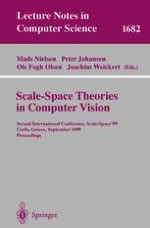1999 | Buch
Scale-Space Theories in Computer Vision
Second International Conference, Scale-Space’99 Corfu, Greece, September 26–27, 1999 Proceedings
herausgegeben von: Mads Nielsen, Peter Johansen, Ole Fogh Olsen, Joachim Weickert
Verlag: Springer Berlin Heidelberg
Buchreihe : Lecture Notes in Computer Science
Enthalten in: Professional Book Archive
